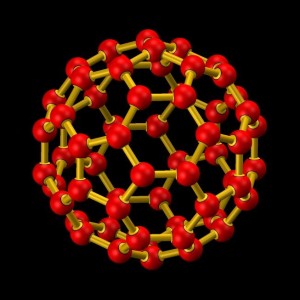Jan 24 2014
If the chemical bonds that hold together the constituent atoms of a molecule could be tuned to become stronger or weaker, certain chemical properties of that molecule might be controlled to great advantage for applications in energy and catalysis. Berkeley Lab researchers at the Molecular Foundry, in collaboration with researchers from Rice University, were able to accomplish this feat by using an applied voltage and electric current to tune the strength of chemical bonds in fullerene or “buckyball” molecules.
The softening of the buckyball chemical bonds was revealed by measured changes in the vibrational frequencies of those bonds.
 The chemical bonds that hold together the 60 atoms of carbon in a fullerene or buckyball molecule can be tuned through the use of an applied voltage and electric current.
The chemical bonds that hold together the 60 atoms of carbon in a fullerene or buckyball molecule can be tuned through the use of an applied voltage and electric current.
“To my knowledge, this measurement is the first demonstration of controllably and reversibly softening bonds between atoms by applying a voltage and running an electric current through a single molecule,” says Jeff Neaton, director of the Molecular Foundry, which is a U.S. Department of Energy (DOE) nanoscience center hosted at Berkeley Lab, and a University of California (UC) Berkeley physics professor. “While the quantitative behavior we witnessed is quite specific to fullerene molecules, such control over the strength of intramolecular bonds could be used down the road to, for example, promote certain chemical reactions, identify mechanisms for device degradation and reduce dissipation mechanisms.”
Contrary to the popular image of chemical bonds as sticks connecting balls that represent the atoms in a molecule, a chemical bond is actually a distribution of electronic charge that bridges two or more atoms, effectively gluing them together. The thermal motion of the atoms gives rise to characteristic vibrational “modes” or frequencies that reflect the strength of their chemical bond. Various vibrational spectroscopy techniques can be used to provide detailed information about these bonds.
Rice University physics professor Douglas Natelson and his graduate student Yajing Li used surface-enhanced Raman spectroscopy to measure the vibrational modes of buckyballs attached to nano-sized antennas made of gold when an electrical current was passed through. They found that the frequencies of the vibrational modes were systematically lowered by the applied voltage, indicating that the chemical bonds had been weakened.
When the applied voltage was removed, the vibrational modes in the buckyballs returned to their normal state. Given that the observed shift in vibrational frequencies was inconsistent with the Stark effect, a well-known molecular spectral response to an electric field, the results called for a new theoretical model.
Working at the Molecular Foundry with Leeor Kronik of the Weizmann Institute of Science in Israel, Neaton and his graduate student Peter Doak developed a theoretical model, and then performed the calculations using the computational facilities of the National Energy Research Scientific Computing Center (NERSC), another DOE national user facility housed at Berkeley Lab.
“We found that the Rice University measurements can be explained in terms of a theoretical model in which the applied voltage slightly increases the average amount of electronic charge on the buckyball, thus tuning the chemical bond strength,” Neaton says. “The implication is that controlling the charge state of a molecule at an interface is a possible means of achieving significant shifts in vibrational energies relative to a pure Stark effect.”
A paper describing this research by Neaton, Natelson and the other collaborators has been published in the Proceedings of the National Academy of Sciences. The paper is titled “Voltage tuning of vibrational mode energies in single-molecule junctions.”
This research was primarily supported by the DOE Office of Science.